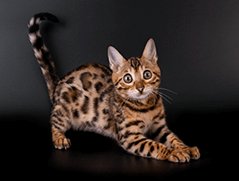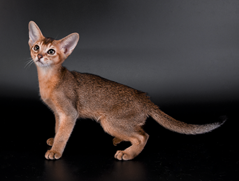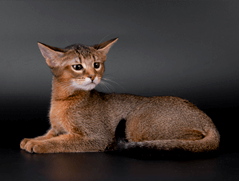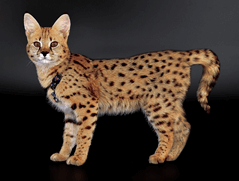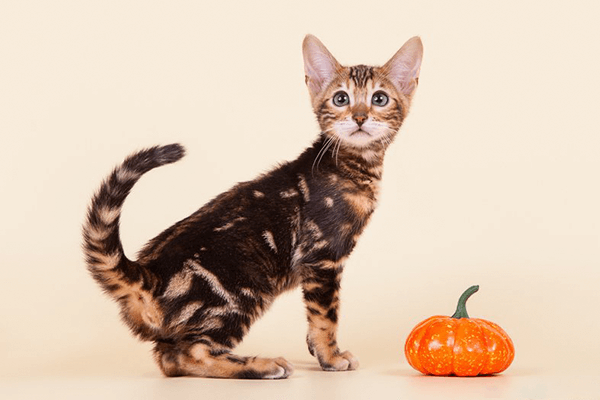 A pronounced feature of the breed of Bengal cats is a color that cannot be confused with any other. It is characterized by a clear pattern of black or brown on a lighter golden brown or silver background. Spotted and marbled patterns are allowed in the TICA breed standards.
A pronounced feature of the breed of Bengal cats is a color that cannot be confused with any other. It is characterized by a clear pattern of black or brown on a lighter golden brown or silver background. Spotted and marbled patterns are allowed in the TICA breed standards.
The spotted pattern is divided into spots, stripes running horizontally along the body, or freely spaced spots and rosettes of various shapes.
The rosette or leopard print is a kind of spots, but it looks more exotic and makes Bengal as similar as possible to its wild ancestor – the Asian leopard cat. In this case, the spots have the shape of a slightly elongated ring or half-ring with uneven edges, similar to flower petals, with the middle in the color of the main background or slightly darker. They can resemble animal footprints or rosettes. With a rosette pattern, the spots should not touch each other and merge.
A mandatory requirement for the varieties of the spotted pattern is that the spots should be located haphazardly along the body or in the form of horizontally directed stripes, in no case forming vertical stripes from the spine to the belly.
The marbled pattern is horizontal streaks and black or brown spots on a lighter background and gives the cat an incredible elegance.
An important requirement for a picture, regardless of its type, is brightness, saturation, clarity of borders, contrast, which is created by combining two, three or more colors. The breed standard in the TICA system recognizes the following colors of Bengal cats: brown – Brown Tabby, silver – Black Silver Tabby, Seal Silver Sepia Tabby, Seal Silver Mink Tabby, Seal Silver Lynx Point, snow – Seal Lynx Point, Seal Mink Tabby, Seal Sepia Tabby.
The most common color of the Bengal cat is brown (Brown tabby (golden)) in all its variety of shades – from golden to deep dark brown. In fact, these are genetically black cats, as evidenced by the dark skin of the pads of the paws and nose, the rims of the eyes and lips, but due to the tabby color (when each hair of the coat is colored in several colors) and the unusual undercoat, brown seems to be the main color.
Silver tabby (silver) and its varieties (Black Silver Tabby, Seal Silver Sepia Tabby, Seal Silver Mink Tabby, Seal Silver Lynx Point) are quite common: the background color is white, silver, each hair, except for white, is painted in black and gray or black. The eyes, lips, nose are outlined in black, which sharply distinguishes them against the background of light wool. The paw pads and tip of the tail are also black.
Snow color is quite rare for a Bengal cat. Depending on the color intensity and brightness of the pattern, snow Bengals are divided into:
- Seal Lynx Point (lynx),
- Seal Mink Tabby (mink),
- Seal Sepia Tabby (sepia).
Lynx color are the lightest of the snowy Bengals. The main color is ivory and a little darker muzzle, paws, tail. Kittens lynx color are born almost white, the pattern – from light red to brown – appears only by 12 months.
Mink color – base color from cream to “coffee with milk”, pattern from auburn to brown.
Sepia color are the darkest of the snowy Bengals. The main background of the fur coat is “a lot of coffee with milk”, the pattern is brown – from light to dark chocolate. Mink and sepia colors are difficult to distinguish between themselves, sometimes it requires an examination.
There is also a number of fundamentally new, and therefore extremely rare and unusual colors.
One of these colors is charcoal – on an anthracite background, as if dusty with gray, a darker deep contrasting black pattern – spots or marble. Genetically, Charcoal Bengals are classified as black or silver Black Tabby, therefore they are exhibited in these color groups. At birth, kittens are practically black, except for the outlined white eyes and a white belly with black spots.
A kind of coal – color “melanistic”. The Melanistic Bengal is your pet panther. Cats of this color are absolutely black, but at a certain angle, the pattern characteristic of Bengals is visible on the animal’s coat.
Even more rarely, in Bengal cats, a blue color is found: on a gray-blue background with a metallic sheen, a darker gray-blue pattern.
Blue, charcoal and black Bengals are not only very rare, but also extraordinarily beautiful.
Today, not only some types of Bengal cat colors are considered exclusive. The long coat of Bengal cats is also exclusive. Initially, kittens with long hair were discarded, but now the long-haired Bengal is attracting more and more interest among breeders and fans of this breed. The long-haired Bengal cat is called Cashmere or Silky Bengal. Since May 2017, Cashmere Bengals have received the right to participate in the championships of the international feline system TICA.
Our Benaby cattery is engaged in breeding Bengal cats of various colors. Here you can buy Bengal kittens, both classic colors, and the rarest – exclusive.

